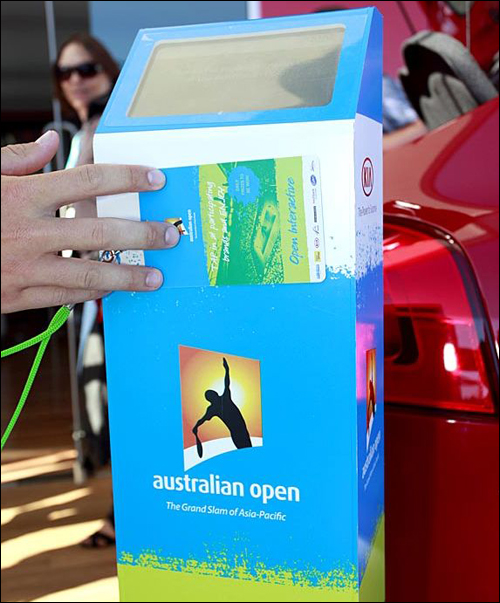More than 20,000 fans at the Australian Open tennis tournament held in Melbourne Park this past January employed radio frequency identification to have their photographs taken, as well as win prizes, communicate with friends via Facebook, or receive a courtesy ride back to the city center.
Tennis Australia—which organized the Australian Open and is the governing body of tennis within that nation—adopted the technology as part of its Open Interactive fan experience, allowing visitors to sign up for an RFID-enabled lanyard, which they could then tap at RFID readers located at sponsors’ booths, in order to receive benefits and earn prizes.

At the Grand Slam Oval, Australian Open’s entertainment precinct, booths were set up by sponsors that included Kia Motors Australia, winemaker Jacob’s Creek, Tourism Victoria, health insurer Medibank, telecommunications firm Optus, chocolate maker Cadbury and fitness program provider Cardio Tennis. The sponsors offered prizes as part of the promotion, including a trip to the United States, mobile phones and a courtesy ride in a Kia car.
Cate Murray, a Tennis Australia executive, says the idea was formed at the company’s annual sponsors’ forum with key clients, in which the businesses discussed current trends and the best way to engage customers in the new digital age. “We were looking at different ways to engage the more than 686,000 people who attend the Australian Open during the two weeks of the tournament, 40 percent of whom attend the visitors’ experience site on the Grand Slam Oval,” she says. “Kia and Jacob’s Creek really drove the interest in RFID technology.”
Fish Technology provided the solution, which the company’s president, Rick Weldon, says included two proprietary RFID readers, installed in Tap Towers. The readers work with tags manufactured with a variety of high frequency (HF) 13.56 MHz chips supporting the ISO 15693 and ISO 18000-3 standards, including NXP Semiconductors‘ Mifare and I-Code SLI ships, as well as Texas Instruments‘ Tag-it model. One Tap Tower was located at the Jacob’s Creek Open Dining licensed meal area, while the other was deployed at the Kia location at the Grand Slam Oval.
“To win the courtesy ride from Jacob’s Creek and Kia, the guests simply had to tap their RFID lanyard at both of the Tap Towers,” Weldon explains. “Once a fan qualified for the ride by tapping both towers, the Fish system sent the guest a text message reminding them to redeem their ride. At the ride location, a Kia brand ambassador used a Samsung Galaxy Note II smartphone with an integrated NFC [Near Field Communication] reader to verify the guest had qualified for the ride, by tapping the phone against the card.
“The system operated outdoors over the course of two weeks, with network connectivity provided by a combination of 4G hotspot devices and Tennis Australia-provided Wi-Fi.”
According to Lisa Tonkin, Kia Motors Australia’s marketing coordinator, the introduction of RFID provided a way to position her firm as a fun and interactive brand at the Australian Open, and to provide consumers with information, test drives and the courtesy ride.
“The courtesy ride was a joint initiative between Kia Motors and Jacob’s Creek,” Tonkin says. “For Kia Motors, it was to provide tennis attendees an in-car experience, and for Jacob’s Creek, it was to expose consumers to their broader marketing message. For both brands, it created a consumer-safety initiative as well.”
Fans could claim the free Kia car rides from Rod Laver Arena, the Australia Open’s main venue, to the Southbank or Southern Cross railway station, thereby reducing the potential for alcohol-related incidents, such as driving while intoxicated.
“The introduction of the RFID system also gave us real-time information about who we were, or were not, interacting with at our booths on the ground,” Tonkin adds.
Another example of the way in which RFID was used, says Tennis Australia’s Murray, was through Tourism Victoria’s initiative involving green-screen technology.
“Patrons with the RFID-enabled lanyard were able to stand in front of a green screen at the Tourism Victoria booth and have their photo taken,” she states, “with different backgrounds of iconic Victorian tourist spots then applied to the green screen.”
A guest could simply tap his or her lanyard on a Galaxy Note II NFC-enabled smartphone, and the photo would then be automatically sent to that person’s e-mail address, or directly to his or her Facebook page, as long as the visitor provided those details upon registering.
“It was surprisingly popular,” Tonkin states.
Other sponsors provided similar experiences, with Medibank allowing guests to interact with health-related activities, and Cadbury providing its own merry-go-round theme ride. All visitors were encouraged to tap the lanyard and ‘like’ the brands on Facebook.
The technology set the participating sponsors apart in a new and interesting way, Murray reports, by enabling them to communicate directly with patrons.
“We are still waiting on a final analysis to determine if we will use the technology again next year,” Murray says. “There were a few teething problems with the Wi-Fi network, because the visitor experience is temporary infrastructure built on an oval, so there were some issues with communication. But the sponsors seemed pleased. Tourism Victoria were particularly pleased, as they don’t traditionally communicate in this way, and they were happy with the customer reach provided by RFID technology.”
Fish Technology’s Weldon confirms that there were 20,000 guest registrations, with an RFID tag and lanyard supplied to every registrant, and approximately 75,000 guest interactions took place throughout the tournament’s duration.

